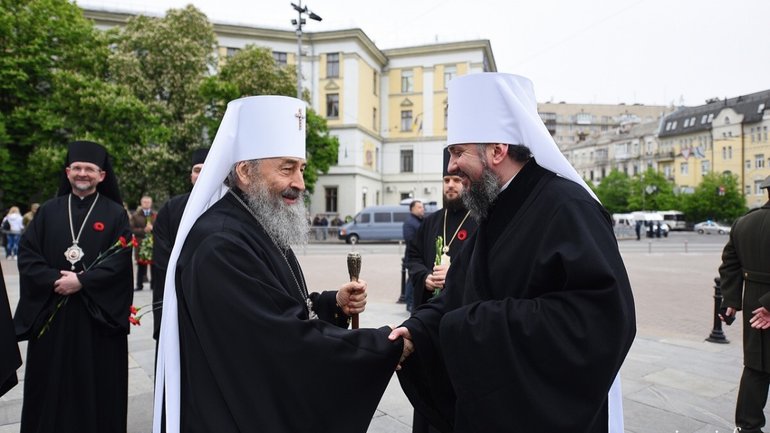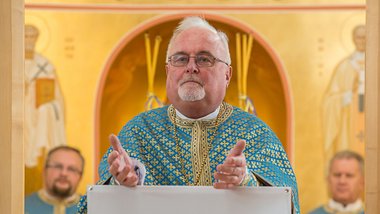A post-war Ukrainian religious reconciliation – An appeal by the CEMES

By Dr Nikolaos Dimitriadis
1.
The Center of Ecumenical, Missiological and Environmental Studies “Metropolitan Panteleimon Papageorgiou” (CEMES), faithful to its vocation and vision, has oriented all its scholarly projects towards Orthodox unity, which has become vulnerable, suffering a serious blow by the last-minute decision of some Churches not to participate in the long-awaited and for nearly a century been prepared Pan-Orthodox Council. This situation was further deteriorated after the decision of the Moscow Patriarchate (MP) to break Eucharistic communion with the Ecumenical Patriarchate (EP) and with those Churches that recognized the Orthodox Church of Ukraine (OCU), and, most recently, with the creation (December 2021) of a Russian Exarchate in the canonical territory of the Patriarchate of Alexandria.
Already before the creation of the OCU, CEMES had launched a project on the issue of a single and unified Orthodox Church in Ukraine. This was studied through the triptych “Primacy-Conciliarity-Autocephaly”, and the final report was published in April 2019, under the title “Peace on Earth and Orthodox Unity. An Appeal to the Orthodox Academic Community”. The report stressed the need to consider “pragmatic proposals,” based on “the actual situation,” taking into consideration that Ukrainians are “open to a closer relationship and even cooperation with their neighbour countries,” and to proceed to “cultural cooperation, exchange of ideas and engaging the younger generation” from all Churches towards mutual enrichment in the social and humanitarian sphere.
2.
In light of Russia’s war against Ukraine, some members of the CEMES expressed their deep concern about the so-called “Russkii Mir” (“Russian world”) ideology (a short of religious and secular imperialism), which in many respects is contrary to the conciliatory and anti-nationalistic tenor of the mission document of the Holy and Great Council “The Mission of the Orthodox Church in Today’s World” and of the document on Orthodox Social Ethos “For the Life of the World”, issued in 2020.
Indeed, the break of the Eucharistic communion between the MP and the four Autocephalous Churches that recognized the autocephaly of the OCU and her Primate, Metr. Epiphanius, should not be seen as an isolated case; the absence of MP from the Holy and the Great Council of 2016, its initial veto to the completion of the pre-conciliar document on autocephaly, and the establishment of the Russian African Exarchate have been understood by many as an escalation to establish a novel model of Panorthodox unity.
In this regard, it has been argued that the Holy Canons, being set in old times, cannot solve current and more complex situations created in new political and geopolitical contexts. Those who follow this mindset may not go as far as abandoning formally the ages-old canonical tradition established by the Ecumenical Councils, but they propose a model of church unity without a First-Protos, that is, without a primacy of honour and service (and with certain prerogatives), which all Orthodox, with no exceptions (and with no theological counterargument) follow at all levels of Church life (diocesan, regional). The CEMES does not argue that we must slavishly follow the Holy Canons with no contextualization of their content; it rather suggests that we do need to keep our canonical tradition faithfully, yet dynamically interpreted. Otherwise, there is a danger to fall into a protestant-style confederation of local, independent/national Orthodox Churches, a situation almost inevitable if the proposal to “leave canons to their past” prevails. And if that happens, one can no longer speak of the “one Church” we confess in the Creed, but of something alien to Orthodox ecclesiology.
Unfortunately, for many centuries after the break of communion with Rome during the 11th century many Orthodox have unconsciously developed a “negative” identity: for them, Orthodoxy is not what tradition has left her as legacy, but what the others, mainly the Catholics, are not. In other words: Orthodoxy is a synodal Church without a primacy, that is, without that visible expression of the Church’s worldwide unity.
Today, synodality is no longer a taboo for the exercise of papal primacy: Pope Francis has stressed that “in the dialogue with our Orthodox brothers and sisters, we Catholics have the opportunity to learn more about the meaning of episcopal collegiality and their experience of synodality” (Evangelii Gaudium, 246). The same correlation (or inter-dependence) between Primacy and Synodality at all levels of Church life was affirmed in the official Orthodox-Catholic dialogue (see the documents of Ravenna and Chieti).
Thus, the refusal of some Orthodox to accept a visible head (a First-Protos, not in jurisdictional but in terms of service to unity) destroys the bases of Church unity. The imperative necessity of having a First-Protos at a universal level, mostly in light of its existence in all other levels (diocesan, metropolitan), inevitably deprives the coherence in our Church’s global witness. Any novel perception of Church unity, based on power or on “number” superiority, as currently promoted, or even on the basis of a Church being the capital of a dominant State or Empire, can hardly have in itself any immediate canonical or ecclesiological effect.
3.
Ukraine’s religious landscape is extremely important, not only because of Russia’s invasion, that is, because of the aggression by a fellow Orthodox State, nor because of Ukraine’s geopolitical status; present Ukraine was in the past centuries the arena of the encounter – or clash – between the two main theological and spiritual streams of Eastern and Western Christianity, namely Orthodoxy and Catholicism. Today it has become the land where past wounds can either be prolonged to the detriment of the Church’s image and her witness to the world or healed through a reconciliation process that could lead Christianity at large to a new ecumenical era and – why not – to the restoration of Church unity.
Ironically enough, the granting of autocephaly to the OCU and the war in Ukraine have brought to a wider ecumenical revival; religious reconciliation in Ukraine is now more possible than it was before the war. In this regard, the contribution of the Ukrainian Greek Catholic Church (UGCC), which openly expressed her view in favor of Ukrainian autocephaly, should not be ignored.
The Greek Catholic Churches were historically developed in the geographic area where the present Russian-Ukrainian conflict is taking place. Many Orthodox consider now these Churches to be no longer an obstacle to peace of the Ukrainian society, but a solid protagonist of Christian common witness and collaboration. Thus, the Ukrainian Greek Catholic community, being in the past a problem in the Ukrainian/Russian history, is one of the main players in fostering social stability and ecumenical relations, in a way that even the “Balamand Declaration” (1993) of the official Orthodox-Catholic dialogue failed to ensure.
4.
As to canonical steps, a practical suggestion towards reconciliation of Ukrainian Orthodoxy could be an interim solution of a “double jurisdiction”. Although this status may not be fully canonical – even in the Orthodox diaspora it has a provisionary force – it seems the only feasible solution that will diminish hatred developed during the past 30 years, exacerbated in the last two years.
This could ensure the integrity of the two Orthodox Churches of Ukraine, their synodal constitution, the existence of a First in each of them, as well as the willingness of the two administrative bodies to be agents of communion and unity and not of division and rivalry. The primacy of the EP could serve not as an obligation to join the OCU, but as a canonical protection for those dioceses that will not want to join initially neither of the two Churches. Besides, the canonical intervention of the EP was completed in 2019 with the granting of Autocephaly, with the return to the canonical status of the millions of Ukrainian faithful, and with the projection of the principles of unity and communion as the reason for the existence of the Church in Ukraine.
Another interim solution may be the creation of a non-official synodical ecclesiastical structure after mutual agreement between the UOC-MP and the OCU. This may be the kairos for Ukrainian inter-Orthodox reconciliation, especially after the non-commemoration of Patriarch Kirill of Moscow by many dioceses and parishes affiliated to the UOC-MP, after Patr. Kirill’s non-condemnation of Russia’s war against Ukraine.
This can be achieved if the model of the 1928 agreement between the EP and the Autocephalous Church of Greece which allowed the so-called “New Lands” in Greece to be temporarily administered by the Autocephalous Church of Greece, i.e., with 6 bishops from EP and 6 from the Autocephalous Church of Greece forming the Permanent Holy Synod, the main executive administrative body. In other words, both the UOC-MP and the OCU should leave aside their civil ecclesiastical controversy and agree in joining forces in their Orthodox Christian witness. During this interim period, a Church administration can be established with a Permanent Synod consisting of and a Synod of all the Orthodox hierarchs, exactly on the model that perfectly operates in the Church of Greece. All these, hopefully by extending their synodality to the “royal priesthood” (both ordained and laypeople) and at all levels of ecclesiastical life, until a full-scale reconciliation and maturity is achieved, and eventually a truly united Orthodox Church in Ukraine emerges.
Such, or similar, solutions can reconcile, in a very short time, all Ukrainian Orthodox making them embrace and not fight one another and be an example to the rest of the Orthodox, and to the whole world, of what Christian love really means!









